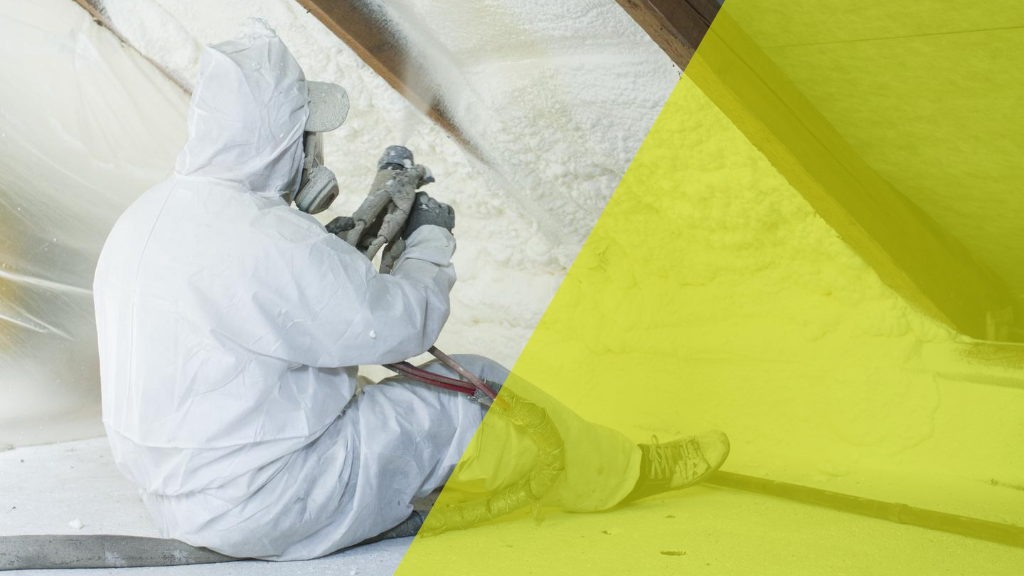Spray Foam: The Ultimate Option for Air Sealing and Insulation
Spray foam insulation has become a leading service for reliable air securing and thermal insulation, supplying a distinct mix of residential or commercial properties that establish it in addition to conventional techniques. Its capacity to expand and load voids makes it particularly efficient in stopping air leak, which can considerably affect power effectiveness. However, comprehending the full range of its benefits, setup procedures, and contrasts with various other insulation kinds is critical for making educated choices. As we discover these facets, the effects for both brand-new building and constructions and retrofits come to be progressively substantial. What variables should affect your option?
What Is Spray Foam?
Spray foam is a flexible insulation product that integrates the principles of air securing and thermal resistance to enhance power performance in buildings. Composed mainly of polyurethane or other comparable substances, spray foam is used as a fluid that expands upon contact with surface areas, developing a solid, constant layer of insulation. This distinct building enables it to load voids, splits, and gaps that typical insulation products might neglect, giving an exceptional air seal.
There are two main kinds of spray foam: open-cell and closed-cell. Open-cell spray foam is lighter and a lot more adaptable, using exceptional sound absorption and a lower R-value per inch - Spray Foam. On the other hand, closed-cell spray foam is denser, offering a higher R-value, moisture resistance, and added structural integrity to building parts
The application procedure commonly includes specialized tools, guaranteeing a smooth application that abides by numerous substrates, consisting of metal, concrete, and wood. This versatility makes spray foam suitable for both new constructions and retrofitting existing structures. Its capability to produce an airtight barrier significantly contributes to minimizing power usage and improving indoor air quality, thus making it a favored selection among home owners and home builders alike.
Advantages of Spray Foam Insulation
One of one of the most considerable advantages of spray foam insulation is its outstanding ability to create a continuous air barrier, which efficiently reduces energy loss. Unlike typical insulation products, spray foam expands to load fractures and gaps, making certain that air leak is substantially minimized. This particular not just improves energy effectiveness but also brings about decrease energy bills over time.
Furthermore, spray foam insulation provides premium thermal resistance, adding to a more secure indoor atmosphere. Its high R-value per inch permits effective insulation in restricted spaces, making it ideal for attics, walls, and crawl spaces. The moisture-resistant residential or commercial properties of spray foam help stop mold and mold development, promoting healthier living problems.
An additional important advantage of spray foam insulation is its sound-dampening top qualities (Spray Foam). It efficiently lowers sound transmission in between areas, producing a quieter and much more comfortable home atmosphere. The sturdiness of spray foam also stands out, as it does not droop or resolve gradually, keeping its performance throughout its life-span
Just How Spray Foam Works
Recognizing how spray foam insulation works is crucial for appreciating its efficiency in air securing and thermal resistance. Spray foam insulation contains two key components: isocyanate and polyol material. When these components are combined, they undertake a chemical reaction that causes the material to expand rapidly, creating a thick foam that loads splits, dental caries, and spaces.
As the foam expands, it complies with surface areas, creating a closed seal that dramatically decreases air seepage. This particular makes spray foam insulation very reliable at stopping drafts and dampness penetration, which can cause power loss and damages gradually. In addition, the closed-cell version of spray foam offers exceptional thermal resistance due to its inflexible structure, successfully lessening warm transfer.
The distinct buildings of spray foam allow it to adapt irregular surface areas, making certain comprehensive protection and a smooth obstacle. Consequently, spray foam insulation not only boosts power efficiency yet additionally adds to improved indoor air high quality by minimizing the accumulation of toxins and allergens. Ultimately, recognizing the technicians behind spray foam emphasizes its duty as a superior option for insulation and air securing in both residential and commercial applications.
Setup Process Introduction

Before installation, the room must be effectively cleansed and prepped, guaranteeing that surface areas are complimentary from particles, moisture, and dirt. This step is critical because pollutants can compromise adhesion and general performance. As soon as the location is prepared, the application involves blending the 2 parts of the spray foam, which broadens upon call and fills gaps efficiently.
Educated experts need to carry out the installment, making use of specific tools to guarantee consistent insurance coverage and optimal density. Safety and security preventative measures, consisting of putting on protective equipment and guaranteeing proper air flow, are important throughout this process. After application, the foam generally cures rapidly, creating a solid obstacle that boosts energy effectiveness.
Contrasting Spray Foam to Typical Insulation
When assessing insulation options, spray foam insulation stands out in contrast to traditional products such as fiberglass and cellulose. Unlike fiberglass and cellulose, which can permit air infiltration, spray foam broadens upon application, filling crevices and voids to produce an impermeable seal.
Furthermore, spray foam gives a higher R-value per inch than conventional insulation types, offering even more efficient thermal resistance in a thinner account. This characteristic is especially beneficial in areas with limited dental caries depth. Moreover, spray foam is immune to dampness and mold growth, Get the facts which can be a significant interest in cellulose and fiberglass, particularly in damp atmospheres.
Nevertheless, spray foam insulation usually carries a higher in advance expense than its traditional equivalents. Property owners must consider this preliminary financial investment against long-term energy financial savings and performance advantages. Ultimately, while both insulation types offer YOURURL.com their purpose, spray foam becomes an advanced solution for modern insulation demands, especially in regards to air sealing and thermal effectiveness.

Conclusion
In recap, spray foam insulation stands for a highly efficient service for achieving optimum air sealing and thermal resistance. Its one-of-a-kind residential properties, including wetness resistance and noise dampening, make it suitable for numerous applications in both brand-new building and constructions and retrofitting projects (Spray Foam). The initial expenses may be higher compared to traditional insulation products, the long-lasting benefits, such as significant energy financial savings and enhanced indoor air top quality, warrant the investment and underscore its value in modern-day structure techniques.
Spray foam insulation has actually emerged as a leading remedy for effective air securing and thermal insulation, offering an one-of-a-kind combination of residential properties that set it apart from traditional methods.Spray foam is a versatile insulation product that incorporates the principles of air securing and thermal resistance to boost energy efficiency in buildings.When assessing insulation options, spray foam insulation stands out in contrast to conventional products such as fiberglass and cellulose. Inevitably, while both insulation types serve their function, spray foam emerges as a more sophisticated option for modern insulation demands, especially in terms of air securing and thermal effectiveness.
In recap, spray foam insulation stands for an extremely reliable option for attaining ideal air securing and more helpful hints thermal resistance.